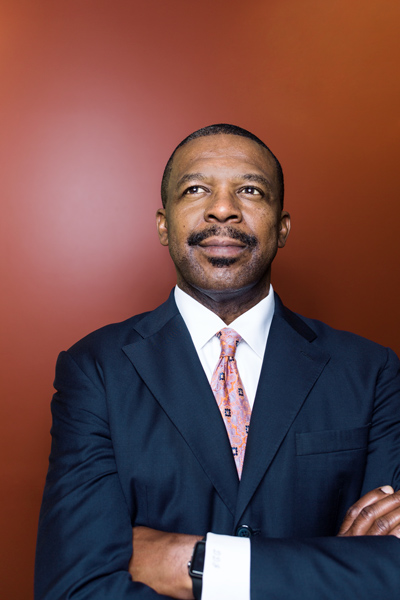
If there’s anything David Jones has carried with him throughout his various career assignments, it’s two important principles.
The first is collaboration. “It has to be work being done with people, not to people,” says the chief human resources officer of Stanford Health Care. “I bring teams together and help them envision the future they want, with the structures and processes to help them get there—involving and engaging people—and giving them a stake in the future is very important.”
The second is courage. “I’m willing to push against the status quo, to raise expectations, and to set demands on both myself as well as on others,” Jones says. “That really stretches people beyond even what they might think is possible in order for them to achieve outcomes and results that were previously unattainable.”
It’s these two principles that helped Jones earn the reputation of being an agent of change—an identity and skill set he brought to Stanford Health Care in 2017. The academic health system has achieved worldwide recognition for its medical breakthroughs in precision health. Its research is intensive, involving custom-tailored treatment solutions based on an individual’s health history and even their DNA profile.
Every organization that Jones has worked for during his career was looking for an HR executive with experience in driving culture change in an industry under massive dislocation and transformation. Fortunately, Jones has been honing his reputation as a change agent since the beginning of his career. He credits that trajectory to his first opportunity when he brought his unique perspective to United Hospital, which was his first CHRO role at the age of twenty-six. And, with the help of a new CEO, Jones helped lead an organization-wide culture change in one of the first hospitals to incorporate Total Quality Management principles.
“The main thing I learned there was the power of employee involvement,” Jones recalls. “We did a lot to create mechanisms to listen to and engage our employees. We documented significant process improvement, customer satisfaction, and employee productivity gains. We also did a lot to change the leadership, from a command-and-control style to one that was more empowering of employees.”
Last year, Jones undertook another major change when he joined Stanford Health Care. At the time, the organization had a new CEO, and virtually all of the senior executive roles were new hires or vacant. “It’s really an opportunity to come in and help elevate the human resources function to a level of preeminence that Stanford is known for,” he says.
But the first order of business was to get a sense of Stanford as an organization, its driving forces for success, and its restraining forces impacting accomplishments. “When you come on board, learn about the strengths, and identify those potential weaknesses, then that’s where you see an opportunity for us to help forge change,” Jones says. “We know that in the healthcare industry there’s going to be more and more competition based on clinical quality, service, and value—and we maybe took our leading position for granted—but those industry forces are starting to impact Stanford Health Care.”
Jones has his work cut out for him. The industry is undergoing some major changes, from regulation to visibility of quality outcomes, and Stanford needs Jones’s change-agent expertise to help move forward. “One of the biggest areas of change is the whole notion of price sensitivity,” he explains. “Many healthcare organizations are finding ways to drive cost down through efficiency, technology, and physician engagement. As a lower cost provider, you’re able to grow your business by being attractive to multiple customer segments. Stanford has never been known for low cost. We cater to high-acuity patients, the sickest patients, the most complex disease entities.” Finding ways to reduce expenses while also maintaining Stanford’s cutting edge reputation will be quite the challenge for Jones and the new leadership team. But it’s also one that he embraces with a receptive mind-set.
“I’m willing to push against the status quo, to raise expectations, and to set demands on both myself as well as on others.”
David Jones
Because of this, no two days are alike for Jones. Whatever the variety, though, his main responsibilities remain to create a vision and strategy to help lead people who will create a meaningful impact on the care that Stanford delivers. Jones says this will require training and developing people to reach their full potential and then having leadership provide direction and accountability.
“One of my biggest goals is building a strong leadership culture so that our leadership team is able to chart a course and set a vision that can help take Stanford into the future for the next ten years and beyond,” Jones says. “It’s really making sure that everything we do in support of our workforce helps us deliver a preeminent employee experience so that our employees can deliver a preeminent patient experience.”
Jones says one way that is achieved is by focusing on how employees experience Stanford Health Care through moments that matter, which are often facilitated by the human resources team. “For example, hiring and onboarding is a process where we have the opportunity to deliver a certain level of service and quality, to define our brand as Stanford Health Care, and gain the loyalty and commitment of our staff,” Jones says. “That’s one example, but all the way through the employee life cycle employees encounter the human resources function. They’re looking for responsiveness and empathy.”
Broad-based ownership is a term Jones echoes frequently, as he believes that change is only possible and effective when the whole team understands the force behind it.
“You have to get people excited about change because they understand what it’s about and how they fit in to make something great happen,” he says. “Everyone wants to be part of a cause that’s bigger than themselves. Everybody wants to feel like they’re contributing to something meaningful and something that will make a significant difference for others. When employees feel this way, you will get inspired performance that engages the heart and soul of each person and brings out their best effort.”
Of course, getting everyone on board isn’t always easy. Jones must formulate strategies to attract and retain a workforce in a highly competitive market in one of the highest cost of living marketplaces in the country. Now, Jones and his team are working tirelessly to build out the team and the processes for a revamped human resources division at Stanford Health Care. His team has already identified some quick wins—areas with great pain points that could be fixed through subtle improvement. For example, in their leave management area, they’ve improved customer focus on how employees apply for leave, the care, and support they get. Other changes that Jones’s team implemented included clarifying the human resources function and developing service standards for resolving issues and improving technology to enhance the employee experience.
Throughout it all, though, Jones remains passionate about his work and being able to focus on the employees at Stanford. “I am able to create a climate where people can do their best work every day, reach their full potential, and deliver on our mission to our patients and families,” he says.
Photo: Gillian Fry

